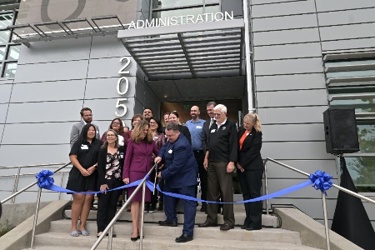San Mateo Celebrates Completion Of $597M Wastewater Treatment Plant Upgrade

Federal, State and Local Officials Cut the Ribbon on the Nation's Most Sustainable Treatment Plant and City's Largest Infrastructure Project
Federal, state, and local leaders joined community members today to cut the ribbon on San Mateo’s new state-of-the-art Wastewater Treatment Plant, the largest component of the City’s $1B Clean Water Program.
The upgraded facility replaces 75-year-old infrastructure, eliminates sewer overflows, and introduces advanced treatment technologies that protect public health and safeguard San Francisco Bay for generations to come.
Notable features include:
- One of the largest BioActiflo systems in the world, enabling treatment of up to 78 million gallons per day during heavy storms.
- A 5.3-million-gallon Underground Flow Equalization System (UFES) at the San Mateo Event Center— one of the largest wastewater storage facilities of its kind in California — preventing neighborhood flooding and protecting the Bay.
- Five-stage Biological Nutrient Removal and Membrane Bioreactor systems, making this one of the most advanced treatment facilities in California.
- A LEED Silver–certified administration building, one of the most sustainable treatment plants in the nation, plus new public pathways, landscaping, and educational signage.
Congressman Kevin Mullin, who helped secure key federal financing, highlighted the importance of the EPA’s WIFIA loan program, which provided $277M in lowinterest funding — saving millions for local ratepayers and ensuring the project could move forward.
Assemblymember Diane Papan’s Office representative Sarah Phelps praised the project as “a true regional success story” and a model for sustainability. She also presented a California State Certificate of Recognition to the City of San Mateo and Foster City/EMID in honor of the achievement.
City Manager Alex Khojikian said, “This project is first and foremost about clean water and sustainability. By investing in advanced treatment technologies, we’re protecting San Francisco Bay, reducing emissions, and preparing for a changing climate. At the same time, we wanted this plant to serve our community in more ways than one — not just as a critical piece of infrastructure, but as a public space with walking paths, art, and educational features that connect residents to the importance of caring for our environment.”
Mayor Rob Newsom added: “Wastewater treatment may not be glamorous, but it is essential. This plant reflects our commitment to San Mateo’s Climate Action Plan — cutting emissions, planning for the future, and protecting public health every single day. It’s quiet work that gives our community peace of mind and ensures the Bay remains healthy for generations.”
Foster City Mayor Stacy Jimenez, speaking on behalf of Foster City and the Estero Municipal Improvement District (EMID), emphasized the power of regional partnership. She noted that no single city could have taken on a project of this magnitude alone. By collaborating across jurisdictions, the communities achieved a resilient, future-ready facility that benefits the entire region.
Construction, led by Sundt (contractor), Jacobs (project and construction management), and HDR (design engineer), , began in 2019 and was completed while the existing plant remained fully operational.
The plant is co-owned by the City of San Mateo and Foster City/EMID and also serves half of Hillsborough, the Crystal Springs County Sanitation District, and parts of Belmont, and unincorporated San Mateo County — serving more than 170,000 residents.
Source: City of San Mateo
